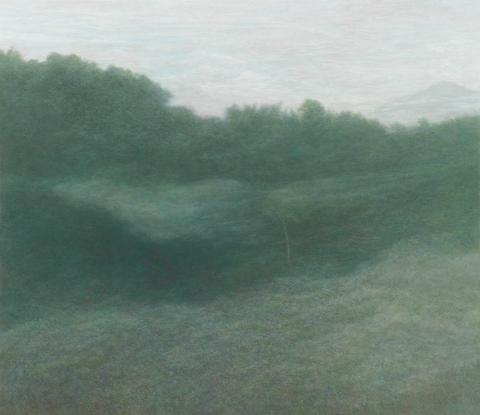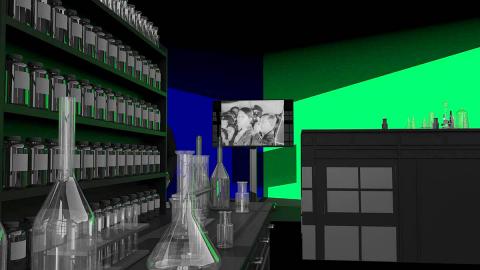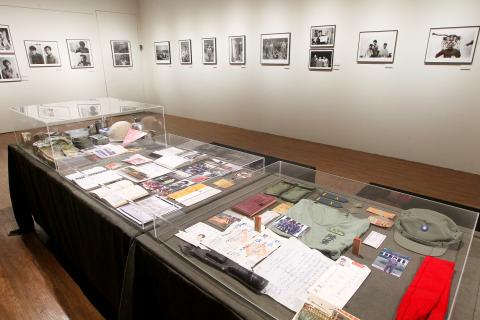Nostalgia Unsettled (未完的鄉愁) and Boundless Life (常日漫漫) are two solo exhibitions jointly held at the Mind Set Art Center. Lin Wei-hsiang (林煒翔) and Chung Shun-wen (鍾舜文) are two Taiwanese painters who share a slow and contemplative temperament in their work. They often borrow motifs from their surroundings, including objects from daily life and the natural sceneries of Taiwan. Lin creates “landscapes in a slow, exquisite and persistent way, [which stands] out from artists of his generation, who are more eager [to explore] new media topics,” writes the gallery in a press release. His recent works show explorations into more abstract material. Chung, on the other hand, has a background in Eastern gouache and is known for her delicate brushwork and meticulous details. Chung says that painting is a way of preserving her memories of Bamboo Hat Hill (笠山), a place where generations of her family have lived. She observes the natural life around her, “cherishes sincere feelings exchanged among people, plant and animals, and tells the richness and delight of life through [art],” writes the gallery.
■ Mind Set Art Center (安卓藝術) 108, Heping E Rd, Taipei City (台北市和平東路108號), tel: (02) 2365-6008. Open Tuesdays to Saturdays from 11am to 6pm
■ From tomorrow to Oct 13

Photo Courtesy of Mind Set Art Center
Soldier (阿兵哥—軍旅記憶) is Taiwan’s first photography show about military life as told from the perspective of the soldier. The group show offers a glimpse into the daily life of Taiwanese military training in the ‘90s. From 1949 to 2004, male citizens of age 18 were required to perform two years of compulsory military service. In 2008, the conscription was shortened to one year and finally this year, the government has declared a cease on mandatory service. Although most male adults in Taiwan share memories of enlistment, there are very few pictures as photography is not allowed in military bases. Under certain official and incidental circumstances, however, three young soldiers were able capture some moments of their lives in military camp. Tian Yu-hua (田裕華) was stationed in Matsu between 1994 and 1996. After winning a 35mm camera as a lottery gift during a military gala, he began taking photographs of his surroundings and the daily life of his peers. Hang Dah-perng (杭大鵬) served in the military press department, where he was assigned to take promotional pictures of soldiers in training and patrol and military demonstrations. Chang Liang-I (張良一) was given clerical duties, including photographing various activities around the military base in Longtan (龍潭).
■ The General Association of Chinese Culture (中華文化總會), 15 Chongqing S Rd Sec 2, Taipei City (台北市重慶南路二段15號), tel: (02) 2396-4256. Open Tuesdays to Saturdays from 10am to 5pm
■ Through Oct 14

Photo Courtesy of National Taiwan Museum of Fine Arts
Taiwan Contemporary Culture Laboratory (臺灣當代文化實驗場), also known as C-LAB, is a new art institution run by the Taiwan Living Arts Foundation of the Ministry of Culture. Based in the former Air Force Command Headquarters, C-LAB dedicates itself to developing a “new cultural ecology” that fosters innovation, experimentation, and “interactive stimulation between various creative ideas.” This month, the space debuts with its inaugurating exhibition The Alternative Guide to Times (時間另類指南). According to the curatorial text, the show is defined as a site for the convergence of different oral histories, artifacts, images, drawings, text and sound. Together, these narratives and materials respond to the history of the exhibition space, which had served as an industrial research center during the Japanese colonial era and military headquarters from 1949 to 2012. One of the highlights is artist Hsu Chia-wei’s (許家維) Industrial Research Institute of Taiwan Governor-General’s Office (台灣總督府工業研究所), which includes a 3D re-imagination of the former research center and documentary films of the Japanese military factory and promotional exposition.
■ C-LAB (臺灣當代文化實驗場), 177, Jianguo S Rd Sec 1, Taipei City (臺北市大安區建國南路一段177號), tel: (02) 8773-5087. Open Tuesdays to Sundays from 1pm to 4pm
■ Through Sept 22

Photo Courtesy of C-LAB Chromesthesia Resonance
Chromesthesia Resonance (聯覺共振) is a group exhibition of audiovisual art curated by new media artist Yeh Ting-hao (葉廷皓). Audiovisual art encompasses works that explore the relationship between hearing and seeing, promoting a more integrated sensory experience, writes Yeh. This art form has greatly evolved along with the progression of technology. The show features six local and international artist groups whose works show different approaches to digital media and ways of connecting with the viewer. The exhibition takes on the theme of chromesthesia, which is a synesthetic phenomenon in which sounds automatically evoke experiences of color. The show focuses on works that involve real-time computation, thus offering unique experiences that are distinct to every viewing moment. Featured works includes virtual reality chambers, reinterpretations of soundscapes, visual translations of aural memories, and an audiovisual take on ikebana, or Japanese flower arranging.
■ National Taiwan Museum of Fine Arts (國立台灣美術館), 2, Wuquan W Rd Sec 1, Taichung City (台中市五權西路一段2號), tel: (04) 2373-3552. Open Tuesdays to Fridays from 9am to 5pm, Saturdays and Sundays from 9am to 6pm
■ Through Nov 18

Photo Courtesy of The General Association of Chinese Culture
Currently on view at the National Palace Museum is an exquisite painting exhibition of Chinese works from the late Qing Dynasty to the early Republican period. A New Era for the Museum Collection: Shanghai Painting Circles of the Late Qing and Early Republican Period (典藏新紀元—清末民初的上海畫壇) features 58 works from the 1850s to 1930s, a time during which the Shanghai art market flourished due the opening of commercial ports in the 1840s. According to the museum, “economic prosperity soon brought about a nouveaux riches class marked in part by insatiable demand for cultural products.” In such a climate, artists from different parts of China migrated to Shanghai to benefit from the thriving painting and calligraphy market. “These paintings were often distinguished by vibrant colors… and easy-to-understand subjects,” the museum states. Collectively known as the Shanghai School, this era of art activity is marked by diverse styles and shared motifs of birds and flowers, landscapes and figure painting. Exhibition highlights include Wu Changshi’s (吳昌碩) Wisteria Blossoms (藤花), a hanging scroll of ink on paper that expressively depicts plant life with lively brush strokes and subdued colors. Yuan An’s Hut in Snow (雪庵袁安), by the same artist, is a solemn portrayal of the tale of Yuan An, an anecdote that conveys the value of moral excellence.
■ National Palace Museum (國立故宮博物院), 221 Zhishan Rd Sec 2, Taipei City (台北市至善路二段221號), tel: (02) 2881-2021. Open daily from 8:30am to 6:30pm; closes at 9pm on Fridays and Saturdays
■ Through Sept 25

That US assistance was a model for Taiwan’s spectacular development success was early recognized by policymakers and analysts. In a report to the US Congress for the fiscal year 1962, former President John F. Kennedy noted Taiwan’s “rapid economic growth,” was “producing a substantial net gain in living.” Kennedy had a stake in Taiwan’s achievements and the US’ official development assistance (ODA) in general: In September 1961, his entreaty to make the 1960s a “decade of development,” and an accompanying proposal for dedicated legislation to this end, had been formalized by congressional passage of the Foreign Assistance Act. Two

Despite the intense sunshine, we were hardly breaking a sweat as we cruised along the flat, dedicated bike lane, well protected from the heat by a canopy of trees. The electric assist on the bikes likely made a difference, too. Far removed from the bustle and noise of the Taichung traffic, we admired the serene rural scenery, making our way over rivers, alongside rice paddies and through pear orchards. Our route for the day covered two bike paths that connect in Fengyuan District (豐原) and are best done together. The Hou-Feng Bike Path (后豐鐵馬道) runs southward from Houli District (后里) while the

March 31 to April 6 On May 13, 1950, National Taiwan University Hospital otolaryngologist Su You-peng (蘇友鵬) was summoned to the director’s office. He thought someone had complained about him practicing the violin at night, but when he entered the room, he knew something was terribly wrong. He saw several burly men who appeared to be government secret agents, and three other resident doctors: internist Hsu Chiang (許強), dermatologist Hu Pao-chen (胡寶珍) and ophthalmologist Hu Hsin-lin (胡鑫麟). They were handcuffed, herded onto two jeeps and taken to the Secrecy Bureau (保密局) for questioning. Su was still in his doctor’s robes at

Mirror mirror on the wall, what’s the fairest Disney live-action remake of them all? Wait, mirror. Hold on a second. Maybe choosing from the likes of Alice in Wonderland (2010), Mulan (2020) and The Lion King (2019) isn’t such a good idea. Mirror, on second thought, what’s on Netflix? Even the most devoted fans would have to acknowledge that these have not been the most illustrious illustrations of Disney magic. At their best (Pete’s Dragon? Cinderella?) they breathe life into old classics that could use a little updating. At their worst, well, blue Will Smith. Given the rapacious rate of remakes in modern